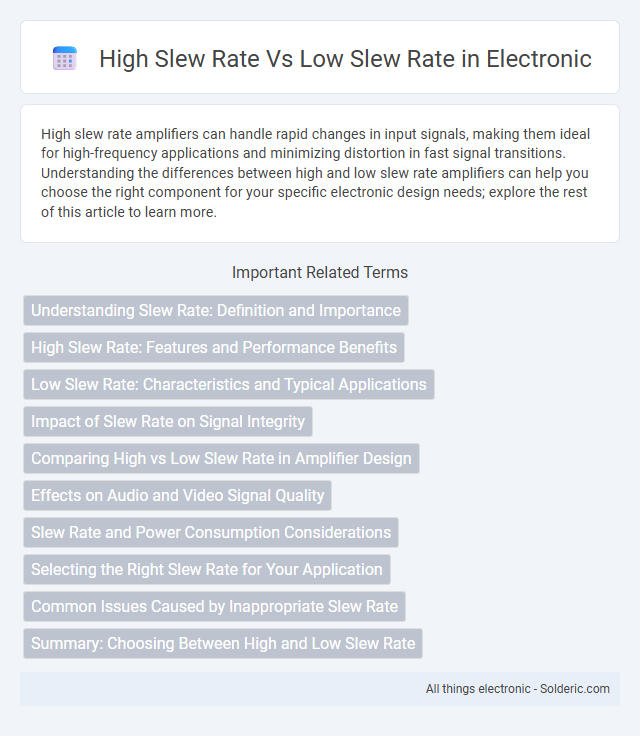High slew rate amplifiers can handle rapid changes in input signals, making them ideal for high-frequency applications and minimizing distortion in fast signal transitions. Understanding the differences between high and low slew rate amplifiers can help you choose the right component for your specific electronic design needs; explore the rest of this article to learn more.
Comparison Table
| Feature | High Slew Rate | Low Slew Rate |
|---|---|---|
| Definition | Fast change of output voltage per unit time (V/us) | Slow change of output voltage per unit time (V/us) |
| Speed | High-speed response | Low-speed response |
| Signal Integrity | Better for high-frequency signals, reduces distortion | May cause distortion at high frequencies |
| Applications | High-speed amplifiers, RF circuits, video signal processing | Audio amplifiers, low-frequency circuits, general purpose |
| Power Consumption | Typically higher power consumption | Lower power consumption |
| Noise and Stability | Potentially higher noise, may require careful design | Generally more stable and less noisy |
Understanding Slew Rate: Definition and Importance
Slew rate measures how quickly an amplifier or operational device can change its output voltage, typically expressed in volts per microsecond (V/us). A high slew rate allows your circuits to handle rapid signal changes without distortion, crucial for high-frequency and fast transient applications such as audio and video processing. Low slew rates may cause signal lag and waveform distortion, impacting overall performance and accuracy in sensitive electronic designs.
High Slew Rate: Features and Performance Benefits
High slew rate amplifiers can rapidly change output voltage, enhancing performance in high-frequency and fast-switching applications. Their fast response time minimizes distortion and signal delay, critical in RF circuits, video processing, and high-speed data acquisition. High slew rate ensures accurate amplification of transient signals, improving overall system fidelity and reliability.
Low Slew Rate: Characteristics and Typical Applications
Low slew rate operational amplifiers exhibit slower output voltage changes, typically measured in volts per microsecond (V/us), making them ideal for low-frequency or precision applications where signal integrity and minimal distortion are critical. Commonly used in audio amplifiers, sensor signal conditioning, and instrumentation amplifiers, low slew rate devices help reduce electromagnetic interference and ensure stable, accurate signal processing. Their design inherently limits high-frequency response, prioritizing noise reduction and precision over speed.
Impact of Slew Rate on Signal Integrity
High slew rate amplifiers enable rapid voltage changes, minimizing distortion and preserving signal integrity in high-frequency applications, whereas low slew rate devices can cause signal lag and waveform distortion, leading to degraded performance. Insufficient slew rate limits the amplifier's ability to accurately reproduce fast transient signals, resulting in slew-induced distortion and increased harmonic content. Optimizing slew rate is crucial for maintaining fidelity in analog and mixed-signal circuits, ensuring clean, accurate signal transmission.
Comparing High vs Low Slew Rate in Amplifier Design
High slew rate amplifiers can handle rapid voltage changes efficiently, essential for high-frequency and fast transient applications, ensuring signal integrity and reduced distortion. Low slew rate amplifiers, while typically consuming less power and producing less noise, may struggle with fast signal edges, causing signal distortion and limiting bandwidth. Your choice depends on balancing speed requirements with power consumption and noise performance in amplifier design.
Effects on Audio and Video Signal Quality
High slew rate in audio and video circuits enables rapid voltage changes, preserving signal integrity and ensuring clear, detailed sound and sharp video images. Low slew rate causes slower signal transitions, leading to distortion, reduced bandwidth, and loss of high-frequency details in both audio and video outputs. Selecting components with appropriate slew rate specifications is critical for maintaining optimal signal quality in multimedia applications.
Slew Rate and Power Consumption Considerations
High slew rate operational amplifiers switch output voltage rapidly, increasing power consumption due to higher transient currents, which can lead to greater heat dissipation in electronic circuits. Low slew rate devices exhibit slower voltage transitions, resulting in reduced power consumption and enhanced energy efficiency, making them suitable for low-power applications. Selecting an optimal slew rate balances signal integrity and power constraints, critical in battery-powered and portable electronic systems.
Selecting the Right Slew Rate for Your Application
Selecting the right slew rate for your application depends on the signal frequency and the need to minimize distortion or noise. High slew rate amplifiers can handle fast voltage changes and are ideal for high-frequency, wide-bandwidth applications, ensuring accurate signal reproduction. Low slew rate devices reduce electromagnetic interference and power consumption, making them suitable for low-frequency or precision tasks where signal integrity over speed is less critical.
Common Issues Caused by Inappropriate Slew Rate
Inappropriate slew rate in electronic circuits often leads to signal distortion, increased electromagnetic interference (EMI), and timing errors, impacting overall system performance. High slew rates can cause ringing, overshoot, and crosstalk, whereas low slew rates result in slow signal transitions, causing data errors in high-frequency applications. Selecting the proper slew rate is critical to balance signal integrity, power consumption, and noise reduction in high-speed digital and analog designs.
Summary: Choosing Between High and Low Slew Rate
High slew rate op-amps can handle rapid signal changes efficiently, making them ideal for high-frequency and fast transient applications, while low slew rate amplifiers offer better stability and lower noise for precision, low-speed tasks. Your choice depends on the application requirements: prioritize high slew rate for video processing or RF circuits, and low slew rate for audio or sensor amplification. Understanding these trade-offs ensures optimized performance and signal integrity in your electronic design.
High slew rate vs Low slew rate Infographic

 solderic.com
solderic.com